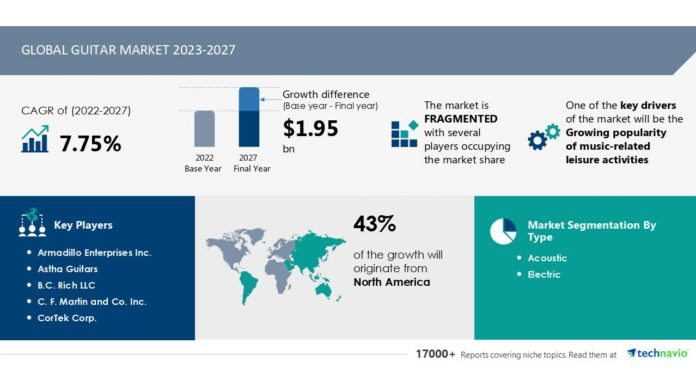The guitar market is estimated to grow by USD 1.29 billion from 2021 to 2026. The market is estimated to be growing at a CAGR of 5.63% during the forecast period. North America is estimated to account for 42% of the global market growth during the forecast period. Factors such as the growing use of online platforms to shop for guitars, the launch of innovative products, and the surging demand for designer guitars facilitate the guitar market growth in North America over the forecast period. The market in this region will grow faster than the growth of the market in the European regions. Hence, such factors drive the regional market growth during the forecast period.
A major factor driving growth of the guitar market is the growing popularity of music-related leisure activities. Globally, people opt for various leisure activities, such as music, traveling, and sports. Such activities offer a break from their hectic and monotonous lifestyles and one of the leisure activities gaining popularity across the globe is learning to play musical instruments. The rising disposable income of people supports the adoption of different musical instruments and their enrollment in music classes. Furthermore, the number of live music shows and those attending such shows is growing rapidly across the world. Hence, such factors drive the growth of the guitar market during the forecast period.
The long replacement cycle will be a major challenge hindering the guitar market during the forecast period. Given their reliability and quality, consumers prefer branded guitars. Since the lifespan of guitars depends on several factors including the environment and the type and ways of playing music, vendors design guitars to withstand extreme operational conditions. These days, vendors manufacture guitars made of high-grade wood and other raw materials, making them lightweight and durable. They also carry out in-depth R&D to introduce innovative and durable materials to extend the lifespan of guitars. Generally, the average lifespan of acoustic guitars is ten years, whereas the average lifespan of electric guitars is almost 20-30 years. But the long lifespan of guitars reduces the frequency of product replacements, which adversely affects the year-over-year growth of the market. hence, such challenges impede market growth during the forecast period.







